The Unblocked Carver
Issue #5: The Shadow Method: Transform Pain Into Unstoppable Creative Genius
Why do some people live creative lives, becoming fulfilled artists and entrepreneurs, finding a sense of deep purpose, while others can't escape the monotony of exhausting routines, or the painful consequences of habitual behaviours?
Do you feel trapped between your creative visions and the harsh realities of daily struggle?
In the story of your life, pain and suffering are a given.
This letter isn't a Tony Robbins motivational speech. It's for those who want to dig into reality and do the deep work that produces lasting transformation, bringing you the agency to live a life of creative purpose.
You've likely found yourself procrastinating creative projects because the struggle of meeting all your obligations and paying your bills has you wanting to numb out in your off time.
Life can be hectic, and it can get heavy. Most of us even procrastinate feeling the inevitably intense emotions associated with the never-ending array of grievances and tragedies.
You even suffer in anticipation of the pains of life. You know about your own mortality, that you'll either get terribly ill, meet your end in a freak accident, or get so old and frail that chewing food is a burden and death comes as a relief.
Chronic pains, seasons of depression, unwanted obligations, lost love, existential despair. Life is full of it all.
Meanwhile, your longing for the truly meaningful life is swept under the rug.
In the words of the beatnik legend, Jack Kerouac:
"I didn't give a goddamn about the mythology and all the names and national flavors of Buddhism, but was just interested in the first of Sakyamuni's four noble truths, "all life is suffering", and to an extent interested in the third, the suppression of suffering can be achieved, which I didn't quite believe was possible then"
We make endless attempts to flee suffering's grasp, and every way we run entangles us further. As presented in the Buddha's first teaching after becoming awakened:
"The noble truth of suffering (dukkha) is this: birth is suffering; aging is suffering; sickness is suffering; death is suffering; sorrow and lamentation, pain, grief, and despair are suffering; association with the unpleasant is suffering; disassociation from the pleasant is suffering; not to get what one wants is suffering. In brief, the five aggregates of attachment are suffering."
But what if I told you that in your suffering lies hidden the keys to freeing your true creative self?
What if the very pain you're running from could become the raw material for your most profound work?
Let me tell you about someone who taught me this through his life, his art, and his extraordinary resilience.
When Pain Becomes Your Teacher
I first heard about Charles Joseph through an unexpected connection. In 2016, a then-relatively unknown psychology professor named Jordan Peterson was becoming greatly respected for his lectures on personality, mythology, and meaning.
(We'll brush past his political involvement and controversies here. Much of Peterson's most important influence has been in helping individuals to find direction and meaning in life.)
In some of these talks, Peterson mentioned his friend Charles, a Kwakwaka'wakw wood carver from the west coast of British Columbia.
I was intrigued by this connection because I'd been studying Indigenous art history as part of my university coursework. The Kwakwaka'wakw are composed of several tribes of Kwak'wala speaking people, known for their rich artistic traditions and ceremonial culture.
The more I learned about Indigenous art, the more I wanted to go to the source. When I discovered there was a master carver I could potentially speak with, I knew I had to reach out.
That first meeting with Charles changed the course of my life.
Charles welcomed me into his home with surprising warmth. For around an hour, he shared stories about his life, his cultural traditions, and the profound meaning behind his art. Despite being a stranger, he treated me with openness and generosity that I couldn't have anticipated.
What struck me most was the contrast between the beauty Charles created and the darkness he had endured. As a survivor of Canada's residential school system, he experienced unimaginable trauma as a child. These government-run, church-administered schools forcibly removed Indigenous children from their families with the explicit goal to "kill the Indian, save the child" — a policy of cultural genocide that left deep wounds across generations.
Yet here was Charles, creating works of stunning beauty and power. His carved masks, totem poles, panels, and canoes weren't attempts to escape his pain, but transformations of it. Each piece spoke to the resilience of his spirit and the depth of his cultural knowledge; his connection to his ancestry.
One particular mask fascinated me. The Crooked Beak mask used in the Hamat'sa, something like a "secretive society" of initiates among Charles' people. This Hamat'sa, central to Kwakwaka'wakw culture, was often misrepresented by early ethnologists who sensationalized it as a "cannibal dance." In reality, it represents a profound psychological journey.
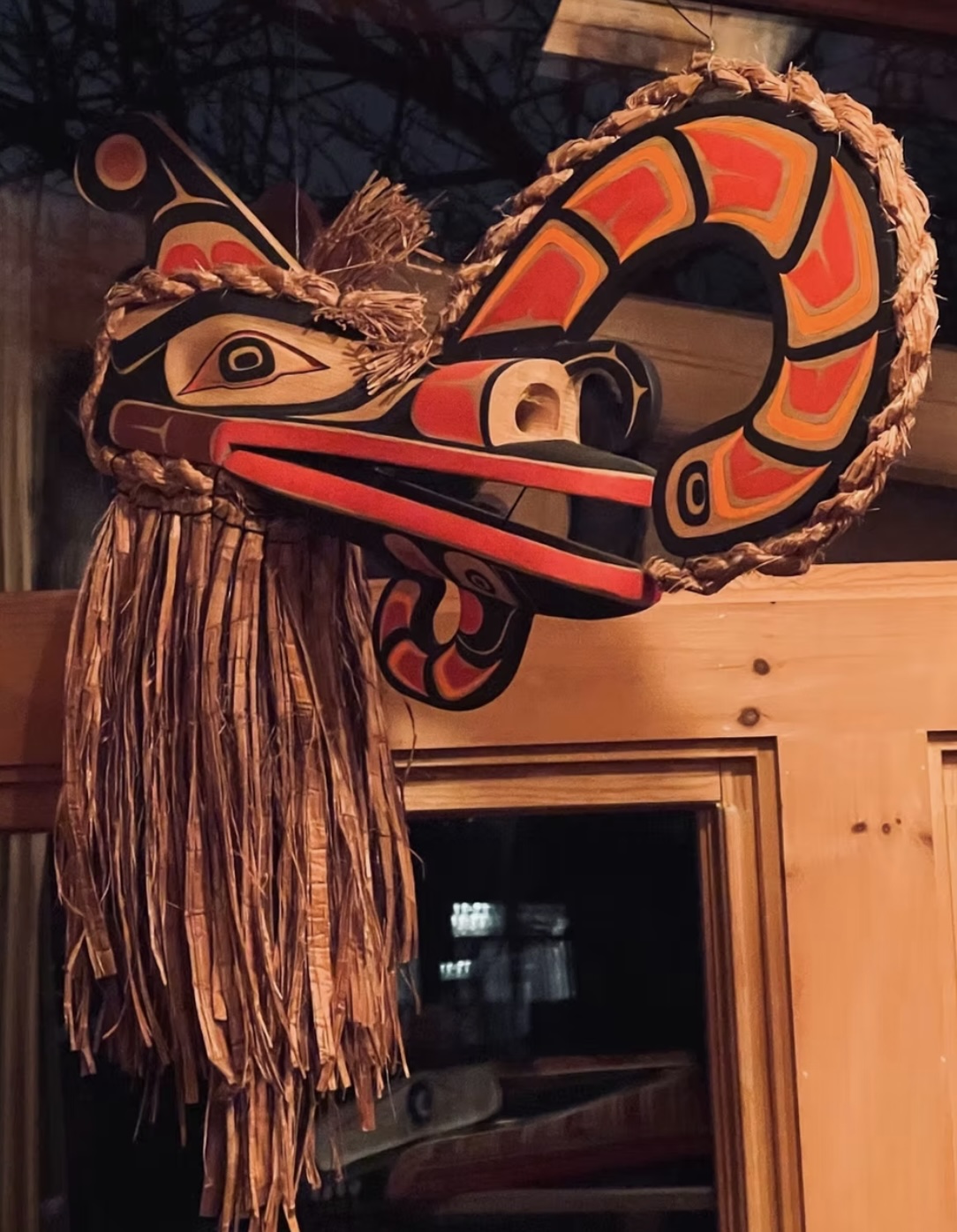
A Crooked Beak Hamat'sa mask carved by Charles Joseph, owned by Jordan Peterson
The Hamat'sa is about transformation. Young initiates venture alone into the wilderness and are symbolically possessed by Baxwbakwalanuksiwe', a mythical cannibal spirit. Upon returning, they perform dramatic dances wearing the distinctive mask with its long beak that loudly snaps open and closed. The community then works to tame this wildness, drumming, dancing, chanting; helping reintegrate the initiate into tribe. The taming of one's own savage nature.
This ceremony embodies something profoundly meaningful: the deliberate confrontation with one's shadow and its subsequent integration. Though outsiders aren't permitted to know all details about the rituals involved, it's clear the event serves a redemptive purpose. The initiate must become civilized, but this requires consciously facing and integrating the monstrous aspects of the self.
Jordan Peterson, with his deep interest in Jungian psychology, was naturally drawn to these potent symbolic practices. He and Charles became close friends.
"Charles and I have been involved in an exceptionally interesting, unlikely and fruitful collaboration for fifteen years [ now over 20 years ]. We've managed to carefully and attentively bridge the gap between our cultures and situations." (JBP)
Carl Jung articulated the idea of the "collective unconscious," and he diverged from the mentorship of Sigmund Freud as he developed what became his pivotal publication: Symbols of Transformation. The rift between Freud and Jung marks a paradigm shift in conceptualizing the unconscious, with Jung's assertion that libido is not only about reproductive drives but much broader psychic energies.
He believed that the shadow, those repressed, denied aspects of our personality, must be consciously encountered and integrated rather than suppressed. When we deny our shadow, it gains power over us.
Art and Inferno
In the years since that first meeting with Charles, he has faced even more extraordinary hardships. His wife Frankie passed away. Shortly after, his home and workshop burned down, also destroying countless valuable artworks including a nearly-completed totem pole that he'd worked on for two years. More recently, he's endured the unimaginable pain of losing two of his kids.

Charles Joseph's home and workshop burning down.
The depth of such suffering is almost incomprehensible. Yet Charles continues to carve, to teach, to father, to share his wisdom with others. His resilience isn't about ignoring pain or putting on a brave face, it's about facing darkness directly and transforming it through creative expression.
The Courageous Journey of Healing
I'm 29 and feel I've been dished a fair share of hardship. Since I was 19, I've battled chronic back pain and headaches. In my search for a manageable lifestyle, I've had over 25 jobs. Despite never being fired, and remaining friends with many employers, no path felt bearable.
I've also struggled with addiction. Kratom, an opioid plant drug, hooked me so deeply that quitting caused four sleepless nights of body-wide agony and weeks of depression. Several times.
As a teenager, I experienced deep depression that skewed my world gray.
There were times in university when pain had me feeling like giving up on life. I never contemplated ending it, but was often dumbfounded regarding what to do. The despair was so heavy and lonely that I felt anger towards almost everybody. I pushed people away, isolated myself, took loved ones for granted, and missed out on so much positive connection.
This is the paradox of suffering: we try to avoid feeling it, yet in doing so, we create more suffering for ourselves and others:
My Own Inferno:
My own path through this paradox wasn't linear or clean. During the worst of my back pain, I developed rituals of avoidance so elaborate they became a second full-time job. I'd cycle through different sitting positions, standing desks, floor desks, lying down with my laptop hovering above me, different kinds of mattresses...anything to try to ease the pain without actually facing its source.
The kratom addiction started innocently enough. Here was a plant medicine that dulled the pain and gave me energy to work. Perfect, I thought. It doesn't even get me "stoned," so mental clarity was mostly unaffected. But as with all shortcuts around suffering, it eventually demanded more than it gave. Halfway through my shifts I'd be hiding away somewhere, chugging a dose of this bitter leaf powder.
Upon quitting: Four nights without sleep, drenched in sweat, every nerve ending screaming. This was the price of admission back into my own life, the toll for crossing from numbness back into feeling. Those nights broke me open in ways I'm still understanding. There's nothing like the dark hours before dawn, when your body is in revolt and your mind is too exhausted to maintain its usual defenses, to reveal what you've been running from.
What I discovered wasn't just physical pain, but a deeper anguish about my place in the world. The creeping suspicion that maybe I didn't belong anywhere, that perhaps my sensitivity to life's hardships meant I wasn't cut out for this existence. This is what Jung might call confronting the shadow: those aspects of ourselves we've disowned, pushed down, refused to acknowledge.
The turning point came not when the physical symptoms subsided, but when I finally stopped fighting against the reality of my situation. I wasn't going to be magically healed. The pain might always be with me in some form. But I could stop adding the second arrow: the suffering about the suffering, the stories I told myself about what the pain meant about me, about my future, about my worth.
Instead of seeing my sensitivity as weakness, what if it was actually a source of strength? What if this pain wasn't meaningless but was instead directing me toward a deeper understanding, and a more purposeful and creative life?
This shift didn't happen overnight. It came through small practices. Sitting in meditation despite the discomfort, writing about the pain instead of around it, learning to carve wood with awareness of my body's limitations rather than fighting against them.
Carving Your Way
When I visit Charles, we sometimes carve together. In those quiet moments, working with wood and sharing stories, I've learned more about healing than in any classroom. The patience required for carving, the attention to grain direction, the acceptance that some cuts will tear out and need repair, becomes a metaphor for working with the difficult material of our lives.
Jordan Peterson and Charles met over twenty years ago, and Charles credits Peterson for much of his personal healing and growth. Charles welcomed him into his family as a brother.
Dr. Peterson had Charles help build the third storey of his house in the style of a traditional Indigenous big house. This space is adorned with Charles' art — totem poles, masks, and various other carvings that transform Peterson's home into a living gallery of Kwakwaka'wakw artistic tradition. It's a physical testament to how deeply Peterson values Charles' cultural heritage and craftsmanship.
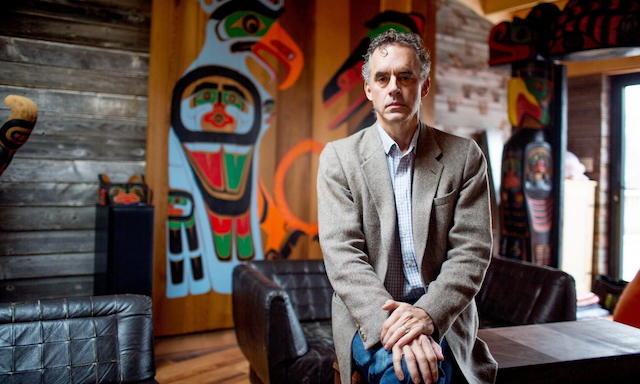
Jordan Peterson in his home, styled with Indigenous artwork
I was fortunate enough to experience the depth of their friendship firsthand. One evening, Charles invited me to attend one of Peterson's talks. The lecture that night was on the topic of "How to Be Grateful in Spite of Your Suffering" — a theme that resonated deeply with what Charles had been teaching me through his life and art.
After the talk, Charles brought me backstage where I met Jordan and his wife Tammy. When Peterson asked how I knew Charles, I found myself explaining that Charles had been teaching me exactly what the night's lecture was about: finding gratitude and meaning despite life's inevitable suffering. The synchronicity of this moment wasn't lost on any of us.
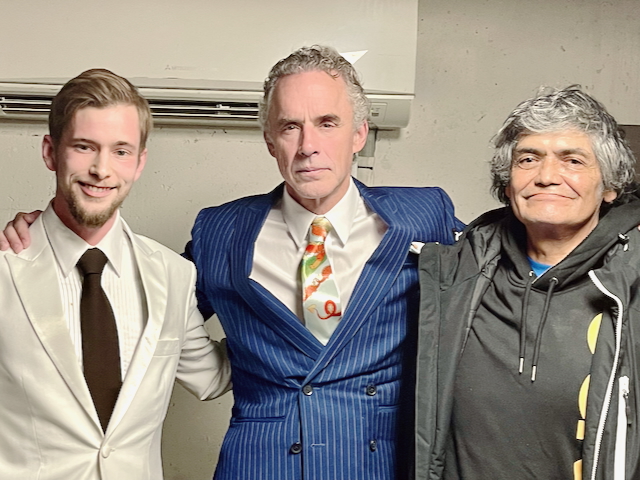
Jordan Peterson, Jesse James Boyes, and Charles Joseph together backstage at Peterson's lecture in Vancouver
What struck me most in that brief backstage conversation was Peterson's insight that gratitude in the face of suffering isn't some passive acceptance, but rather a profound call to courage. This perspective echoed what I'd been learning through Charles' example.
Circumambulation
Peterson explains this process through the concept of "circumambulation," which he takes from Jung. It's the idea that we have a potential future self — everything we could become — and it manifests moment to moment by making us interested in things. These interests aren't random but point us in the direction of our maximal development.
"The things that grab your interest aren't arbitrary, they're pointing you in a direction and the direction that they're pointing you is the direction of your maximal development."
But this journey isn't linear. We stumble, make mistakes, and often feel lost. Peterson notes:
"When new parts of people manifest themselves and grip their interests, they do it very badly and shoddily, and so you stumble around like an idiot when you try to do something new."
This is why many of us avoid the path of maximal development. We're afraid to be fools, to feel incompetent, to face our shortcomings. But as Peterson points out:
"The fool is the precursor to the Savior from the symbolic perspective because you have to be a fool before you can be a master and if you're not willing to be a fool then you can't be a master."
When we embrace this process — the stumbling, the uncertainty, the temporary feeling of being lost — we allow for genuine transformation. Our path isn't a straight line upward, but is:
"punctuated by intermittent deserts… essentially by intermittent catastrophes."
Sitting with Charles, hearing his stories, I've learned something profound about the attitudes and ideas that allow someone to live with purpose and meaning while necessarily overcoming tremendous hardship. The terrible things that have happened to us, or things we've done and feel shame and guilt about, can become a burden too heavy to bear.
These things must have a new awareness brought to them. You have to sit with your emotions without rejecting or running from them, no matter how terrifying they are. It takes heroic courage to heal. Forgiving oneself and others, and finding some way to express the pain becomes the process of reconciliation between you and existence itself.
Tools for the Creative Wayfinder
How do we begin this journey of transformation? How do we turn our suffering into creative power? Through my own struggles and the wisdom shared by mentors like Charles, I've found several crucial practices that can guide us.
Name Your Shadow: What Are You Running From?
The first step is the hardest. Facing what you've been avoiding. Jung wrote:
"Until you make the unconscious conscious, it will direct your life and you will call it fate."
Our unacknowledged pain doesn't simply disappear. It operates behind the scenes, influencing our decisions, relationships, and creative blocks. Naming your shadow means asking difficult questions:
What emotions do I avoid feeling? What parts of myself do I reject or hide from others? What stories do I tell myself that keep me small and safe? What ways do I harshly judge others to avoid acknowledging realities about myself?
This isn't about wallowing in pain but bringing awareness to it.
For me, acknowledging my addictions and the ways I have avoided facing difficult emotions was excruciating but necessary. Only by naming these patterns could I begin to change them.
Find Your Mentors: Seek Those Who've Walked Through Fire
We aren't meant to transform alone. Throughout history, initiatory practices have included guides. Elders who have made the journey themselves and can help others navigate the path.
Charles became such a guide for me, showing through his life and work that even the deepest suffering can be transformed. His willingness to share his knowledge despite his own pain modelled a kind of generosity I aspire to embody.
Finding mentors doesn't always mean securing formal relationships. It can mean studying those who inspire you, reading their words, observing how they've navigated their own darkness. The key is to seek wisdom from those who don't offer simplistic solutions or toxic positivity, but who acknowledge the reality of suffering while demonstrating the possibility of meaningful transformation.
Reading the letters of Seneca the Younger, for example, has greatly encouraged and equipped me with greater emotional resilience.
"What need is there to weep over parts of life? The whole of it calls for tears. New ills will press on before you have done with the old. Therefore, you must bear up bravely." (Letters to Lucilius, 98.14)
"Fate leads the willing, and drags along the reluctant." (Letters to Lucilius, 107.11)
Create With Intention: Turn Pain Into Beauty
This is where transformation becomes tangible. Creating, whether through art, writing, music, or any form of expression, gives form to our inner experience. It allows us to externalize what might otherwise remain trapped within. Otherwise, the body keeps a tab, and it adds up.
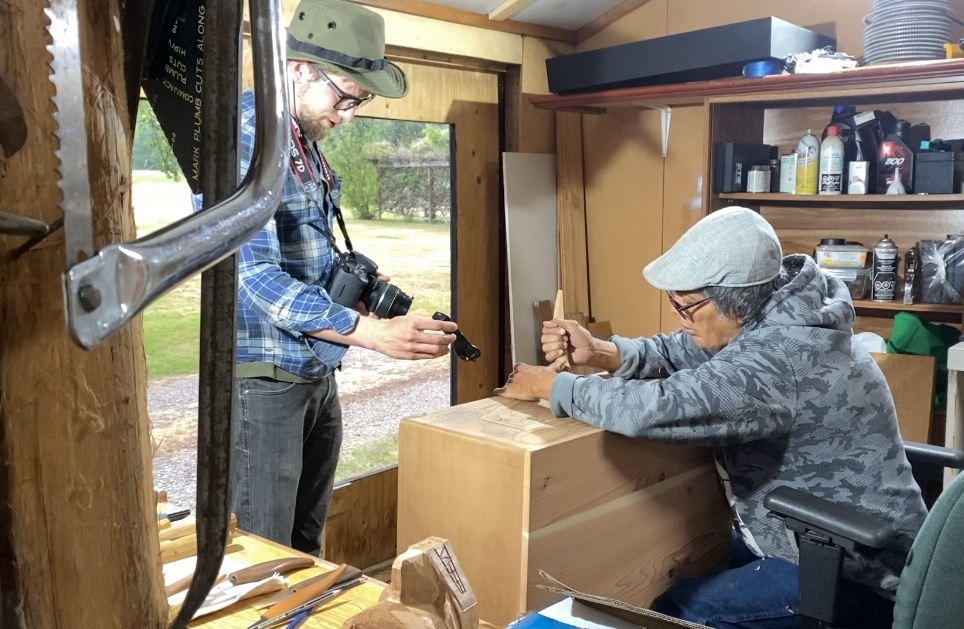
Jesse James Boyes filming Charles Joseph while he carves a bentwood box
Charles' carving practice isn't separate from his spiritual journey. It is his spiritual journey. Each mask, totem, or panel is a dialogue with tradition, with materials, with his own inner landscape. The Crooked Beak mask doesn't deny the existence of the monstrous; it gives it form while containing it within the boundaries of culture and meaning.
Your creative practice doesn't have to be artistic in the conventional sense. It might be how you parent, how you cook, how you tend a garden. What matters is the intention to transform experience into something meaningful, to create something that didn't exist before. Even moving your body in new ways is part of this. Song and dance.
For me, both carving and writing have become ways to work with difficult material. The patience required, the acceptance of imperfection, the gradual revealing of what wants to emerge. These aspects of creation mirror the inner work of transformation.
Build Community: Share Your Journey
Healing happens in relationship.
The Hamat'sa ceremony shows us this. The wild initiate isn't left alone with his transformation but is ceremonially welcomed back into the community, which plays an active role in his reintegration.
When we share our journey with others, not from a place of having it all figured out, but from authentic engagement with our process, we create space for collective healing. Your willingness to bravely acknowledge your struggles might be exactly what someone else needs to face their own.
Charles has built community through his teaching and art, creating spaces where cultural knowledge can be preserved and shared. Peterson has done this through his lectures and books, offering tools for others on similar journeys.
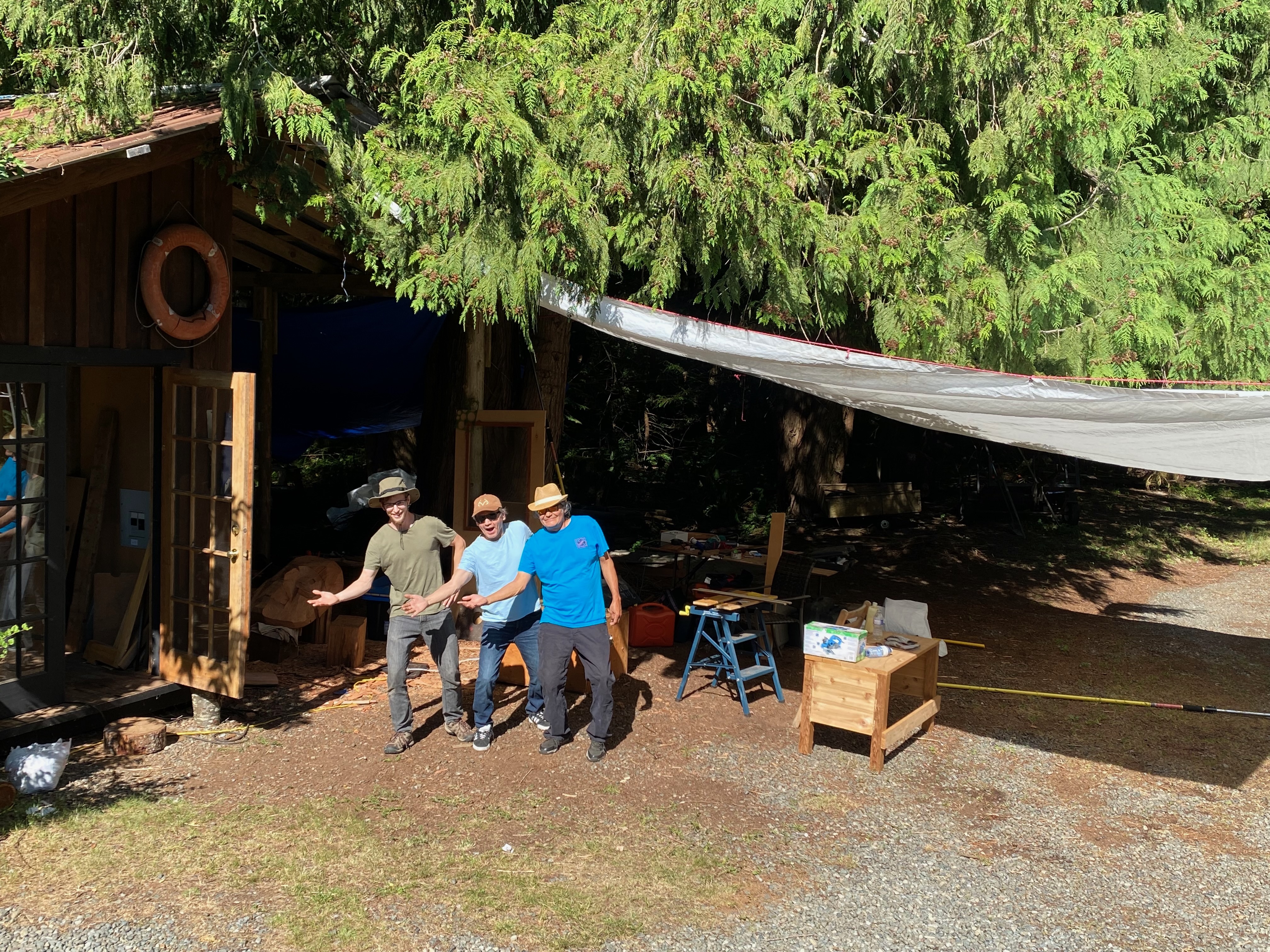
Jesse James Boyes with Charles Joseph and his cousin Barry Scow, another carver
You might do this through conversations with friends, through sharing your creative work, or through mentoring others when you're ready. I've found myself hosting art parties at my home, where friends bring different supplies to work on their own projects in an encouraging social environment. The point isn't to position yourself as having transcended suffering, but to walk alongside others as we all navigate its terrain.
The Uncarved Block
Loy Ching-Yuen, whose teachings were translated by one of my mentors, author Trevor Carolan, wrote:
"In moments of darkness and pain, remember all is cyclical. Sit quietly behind your wooden door: spring will come again."
This patient awareness, this willingness to sit with darkness knowing it contains the seeds of new growth, is at the heart of transformation.
In Taoist philosophy, the concept of "the uncarved block" (p'u) represents our original nature, full of potential, before the world or mind imposes its ideas. As Loy Ching-Yuen writes:
"This perfection of 'the uncarved block' or 'the unshaped, unformed, unborn' is specifically emphasized here because it is the key to all Taoist doctrine."
Paradoxically, by facing our wounds — the very ways in which life has "carved" us — we can return to something essential within us. Not through escape or denial, but through the integration that comes from conscious engagement with all aspects of our experience.
"Carve a piece of wood and it turns into a tool
Employ a sage and he turns into a functionary
Great carving does no cutting." — (Red Pine's rendition of the Tao Te Ching)
Don't mind the rather cryptic nature of the Tao Te Ching, Lao Tzu's ancient pocketbook of wisdom. This quirky text encourages slow contemplation.
The point is that your suffering isn't a mistake to be corrected, or an obstacle to be removed from your path. It is the path itself. It's the raw material from which your most authentic creative expression can emerge.
This wisdom about the uncarved block wasn't something I stumbled upon by accident. It came to me through another crucial mentor who helped shape my understanding of suffering and creativity: Dr. Trevor Carolan.
I registered for his class at the University of the Fraser Valley. What I couldn't have known then was how profoundly this relationship would shape my creative path.
Trevor wasn't just an academic; he was a living bridge between the modern world and ancient wisdom.
He introduced me to Hōjōki, a 13th-century Japanese text written by the recluse Kamo-no-Chomei.
Hōjōki documents a series of devastating calamities. Fires, whirlwinds, famine, and plague struck Japan in the 12th century. Chomei, witnessing unfathomable suffering, eventually retreats to a ten-foot square hut in the mountains.
At first, this seems like a spiritual victory, a monastic achievement. But in the text's final turn, Chomei realizes something profound: "Buddha taught we must not be attached," he writes, confessing, "the way I love this hut is itself attachment."
What struck me about this text was how it mirrored my own journey. Like Chomei, I had often sought to escape suffering rather than face it directly. I'd moved from job to job, home to home, seeking that perfect place where pain couldn't reach me. But as Trevor helped me understand, this approach was itself a form of attachment…..attachment to the idea that life could or should be free from suffering.
During office hours, Trevor would sometimes sit and talk with me for hours. One day while we sat in his office, he poured us two cups of medicinal reishi mushroom tea, and told me of the time he asked Buddhist teacher Thich Nhat Hanh what happens when we die.
As he writes of this story in Mindfulness Bell: A Profile of Thich Nhat Hanh,
"If we observe things mindfully and profoundly," he (Hanh) explained, "we find out that self is made up only of non-self elements. If we look deeply into a flower, what do we see? We also see sunshine, a cloud, the earth, minerals, the gardener, the complete cosmos. Why? Because the flower is composed of these non-flower elements: that's what we find out. And, like this flower, our body too is made up of everything else—except for one element: a separate self or existence. This is the teaching of 'non-self' in Buddhism."
In order to just be ourself, we must also take care of the non-self elements. We all know this, that we cannot be without other people, other species, but very often we forget that being is really inter-being; that living beings are made only of non-living elements. (Carolan, Shambhala Sun, 1996)
"This is how we face life," Trevor told me, carefully refilling our tea cups. "One cup at a time, with full attention."
Through these teachings, I began to understand that creativity isn't about escaping the world's suffering but about engaging with it fully, with awareness and compassion.
Like Charles carving beauty from wood that has weathered storms, split, and healed with interesting grain patterns, you can transform your pain into something meaningful and purposeful. Not despite your suffering, but through it.
This summer, I'll be launching a course and online community for you to explore these themes and tools in depth, offering a practical path forward for those seeking to radically transform their relationship with creativity and suffering. Click here for early access.
"It doesn't matter that it's imperfect, it just matters that you do it and that you move forward."
Whatever creative path calls to you, remember that your wounds don't disqualify you from walking it. Properly transformed, they may be precisely what allows you to create work of lasting meaning and beauty.
Jesse James Boyes